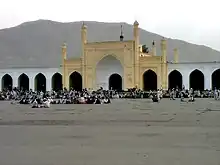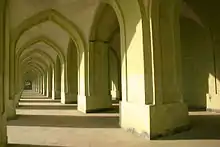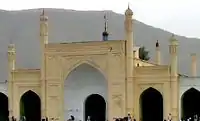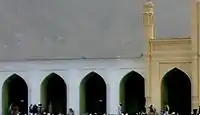| Id Gah Mosque Idgah Mosque Eidgah Mosque | |
|---|---|
 | |
| Religion | |
| Affiliation | Islam |
| District | Kabul District |
| Province | Kabul Province |
| Region | Shar-e-barq, Kabul |
| Rite | Abdali |
| Leadership | Babur or Jahangir |
| Year consecrated | 16th Century |
| Location | |
| Location | Kabul, Afghanistan |
| Geographic coordinates | 34°31′04″N 69°11′24″E / 34.5178°N 69.1900°E |
| Architecture | |
| Type | Mosque |
| Style | Islamic architecture, Mughal style |
Eid Gah Mosque or Id Gah Mosque (Dari: مسجد عیدگاه), is the second largest mosque in Kabul, the capital of Afghanistan. It is considered the cardinal religious mosque in the country, where a million people offer Eid prayers twice a year. It is located near the Mahmud Khan bridge and National Stadium in the eastern part of the city, in the Shar-e-barq of Kabul, which is one of the wealthier areas of the city. The "Id Gah" or "Eid Gah" refers to an open space where people congregate during national and religious celebrations. The open grounds of Id Gah are also used as a parking lot for trucks that transport goods to and from Peshawar.[1]
In most references Babur, a Muslim warrior at the time had just invaded India and ordered a Mosque be built to glorify Islam, he had his warriors bring back precious stone from the Punjab, Sindh and surrounding areas and had Persian architects build a structure for his Kabul subjects. It has been the scene of religious festivals, religious ceremonies, state functions such as coronations and priestly religious ceremonies attended by Kings and Amirs. It was from this mosque that the then Amir Habibullah made his historic announcement of his country's independence, in 1919.[2][3][4][5]
The Id Gah Mosque was stated to be a target of attack when two suspects were arrested on February 10, 2006 with their vehicle found loaded with 8 kg of explosives.[6]
History

Id Gah Mosque was commissioned by Babur the ruler of the Mughal empire before being renovated on a large scale by King Abdur Rahman Khan in 1893 or before. Another story relates to Jahangir being the original builder of this mosque, using local quarries and materials as Kabul was a key mughal city works of art were often commissioned here.
Afghan history records indicate that in 1901, the then Emir of Afghanistan, the head of the state, publicly performed the priestly functions by celebrating the Id at Id Gah Mosque. The chief priest of Kabul immediately proclaimed Habibullah to be the successor of Mohamed, whereupon the Emir of Afghanistan delivered an address inspired by an "intolerant ecclesiasticism". Among other things the Amir passed a dictum that a fine of up to ten Kabuli Rupees would be levied on all who did not offer prayers in the mosques. A register of the daily attendance of all individuals was to be kept in various places and a “box of justice” was to be kept into which secret reports could be dropped reporting on people who had not obeyed this dictum of compulsory attendance for religious prayers at the mosques.[7]
In 1914–15, the bitter feud between Britain and Afghanistan assumed the proportions of a holy war or jihad, even though the new ruler Emir Habibullah had initially opposed this approach of the mullahs. After his ascension to the throne in 1919, he aligned with the mullahs to attack British bases. Before he launched a war on May 15, 1919, the Emir made a speech at the Id Gah Mosque in Kabul urging his countrymen to wage jihad against the British.
The treacherous and deceitful English Government…twice shamelessly attacked our beloved country and plunged their filthy claws into the region of the vital parts of our dear country which is the burial ground of our ancestors and the abode of the chastity of our mothers and sisters and intended to deprive us of very existence, of the safety of our honour and virtue, of our liberty and happiness, and of our national dignity and nobility…It became incumbent upon your King to proclaim jehad in the path of God against the perfidious English Government. God is great. God is great. God is great.
After the Third Anglo-Afghan War, on August 19, 1919, Emir Amanullah announced Afghanistan's independence from this mosque.[9]
On September 21, 2010 a demonstration took place at the mosque.[10]
On October 3, 2021 a bomb attack at the mosque killed several people.[11]
Architecture


Id Gah Mosque is located in an affluent part of Kabul and reflects the rich Muslim architecture and heritage. It attracts pilgrims from far-afield to visit this holy place. The mosque is painted in beige and white and has four minarets at the front, two flanking the higher central arch and then one either side of the arched sections on either side of the central arch. There are in turn four minarets assembled in the same fashion on the other side and a single smaller minaret of a different color in the centre of the roof. The mosque is a very long building and narrow in width. Excluding the prominent central beige painted area of 3 archways, the mosque has 18 dark archways either side along its length. The courtyard area, known as Eid Gah Square, is vast and is capable of holding massive populations of Muslims who attend the mosque during the prayer season.
References
- ↑ "Kabul". Let Us Explore. Archived from the original on 2011-11-14. Retrieved 2010-10-27.
{{cite web}}: CS1 maint: bot: original URL status unknown (link) - ↑ "An Historical Guide to Kabul". [51] Return to the Stadium. American International School of Kabul. Archived from the original on 2010-11-13. Retrieved 2010-10-26.
- ↑ "Id Gah Mosque". Arch Net Digital Library. Archived from the original on 2011-06-29. Retrieved 2010-10-26.
- ↑ "Kabul Travel". Id Gah Mosque. Kabul Travel. Archived from the original on 2010-08-21. Retrieved 2010-10-26.
- ↑ "Urban History and Development of Kabul" (PDF). Switzerland: 10th Architecture & Behaviour Colloqium. 2004. pp. 15–16. Archived from the original (PDF) on 2011-07-06. Retrieved 2010-10-25.
- ↑ IntelCenter Terrorism Incident Reference (TIR): Afghanistan, 2000-2007. Tempest Publishing. 2008. p. 209. ISBN 978-0-9665437-8-0. Retrieved 2010-10-27.
- ↑ Hamilton, Angus (1906). Afghanistan. W. Heinemann. p. 439. Retrieved 2010-10-25.
Id Gah Mosque, Kabul.
- ↑ Edwards, David B. (2002). Before Taliban: genealogies of the Afghan jihad. University of California Press. p. 79. ISBN 0-520-22861-8. Retrieved 2010-10-25.
- ↑ Amir Amanullah Khan. Afghanistan Culture. Archived from the original on 2017-07-25. Retrieved 2010-10-29.
- ↑ "A demonstration has formed at Eid Gah mosque, 1.2 miles south of the Embassy. This area is off limits". Embassy of the United States, Kabul. Archived from the original on 2016-03-03. Retrieved 2010-10-27.
- ↑ "Afghanistan: Several people killed by bomb attack near a Kabul mosque". BBC News. 2021-10-03. Retrieved 2021-10-03.
